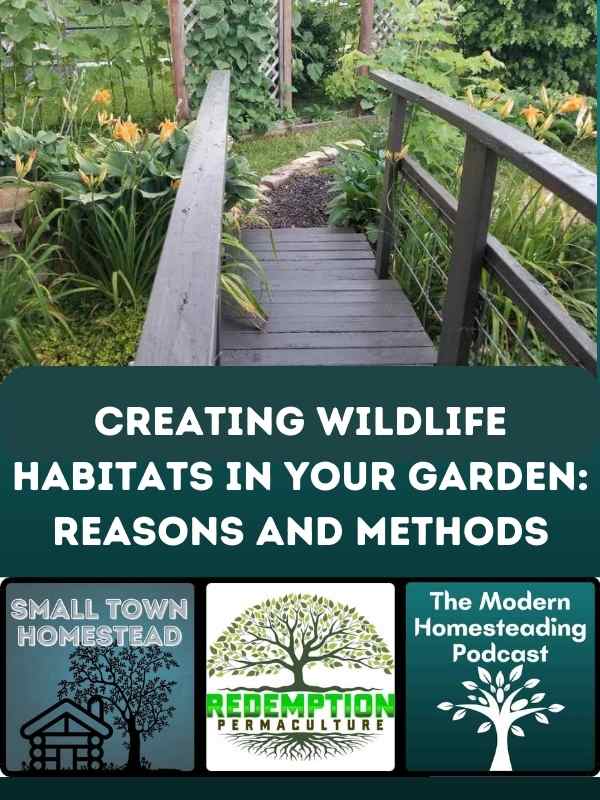Wildlife habitats in our gardens serve as crucial sanctuaries for various species, allowing them to flourish and offering homeowners a chance to reconnect with nature. The degradation of natural habitats around the world underscores the importance of establishing safe spaces for animals, birds, and insects even within our urbanized environments.

In this article, we delve into the reasons for creating such habitats and the various methods you can employ.
Reasons to Consider Creating Wildlife Habitats in Your Garden
Biodiversity Enhancement Maintaining biodiversity is vital for ecosystem stability and health. By creating habitats in your garden, you provide refuge for various species, increasing the local biodiversity and creating a balanced environment.
Natural Pest Control Certain wildlife species, such as birds and ladybugs, feed on common garden pests. By attracting these beneficial species, you can keep pest populations in check without resorting to chemical interventions.
Pollination Boost Bees, butterflies, and other pollinators play a pivotal role in plant reproduction. By attracting these creatures, you can enhance the pollination of your plants, leading to better yields in vegetable gardens and more vibrant flower blooms.
Educational Opportunity A garden teeming with wildlife offers countless opportunities for learning. Children can observe the habits and behaviors of various species, fostering a deeper appreciation for nature and the environment.
Aesthetic Appeal A garden bustling with birds, butterflies, and small mammals adds a dynamic beauty that’s both refreshing and captivating. Their activities and songs can transform your garden into a tranquil, lively haven.
Wildlife You Can Attract By Creating Habitat
When considering the types of wildlife for which to create habitats in your garden, the choices often depend on your geographic location and the size of your garden. However, a broad list of wildlife that benefits from garden habitats includes:
Birds
- Garden Birds: These include robins, sparrows, finches, chickadees, and more.
- Birds of Prey: While it’s harder to cater specifically to them, larger gardens or those near open spaces might attract hawks or owls.
- Migratory Birds: Providing food and shelter can aid birds during their long migratory journeys.

Mammals
- Small Mammals: Animals such as hedgehogs, squirrels, and bats benefit from garden habitats.
- Larger Mammals: Depending on where you live, you might attract deer, foxes, or even raccoons. They need larger habitats, but simple water sources or fruit-bearing plants can be appealing to them.
Amphibians
- Frogs and Toads: They help control pests and can be attracted with water features.
- Newts and Salamanders: Often found in damp, shaded areas of gardens.
Insects
- Pollinators: This includes a range of species such as bees, butterflies, and certain beetles.
- Beneficial Predators: Ladybugs, spiders, and mantises help naturally control pest populations.
- Moths: Beneficial for nocturnal pollination and as a food source for other wildlife.
Reptiles
- Lizards and Skinks: They thrive in gardens with sunny spots and hiding places.
- Snakes: While some people may be hesitant, non-venomous snakes can be beneficial for controlling pests.
Aquatic Life
- Fish: If you have a pond, it can support various fish species.
- Aquatic Insects: Dragonflies, damselflies, and water beetles can all thrive in garden water features.
- Tadpoles and Aquatic Larvae: These are food for many other animals and indicate a healthy water ecosystem.

Beneficial Microorganisms
- Earthworms: They improve soil quality by aerating it.
- Decomposers: Fungi and bacteria that help break down organic material, enriching the soil.
Tips for Attracting Specific Wildlife
- Research Local Species: Understanding the native species in your area helps in providing the right habitats.
- Consult Local Wildlife Organizations: They can offer advice on creating suitable habitats.
- Keep It Natural: Avoid pesticides and use natural, organic gardening methods.
Remember, it’s essential to create habitats that match the needs and preferences of local wildlife. Not only does this benefit the creatures themselves, but it also ensures a balanced, harmonious environment in your garden.
Ways to Create Wildlife Habitats in Your Garden
Plant Native Species Native plants are naturally suited to your local environment and will attract local wildlife. They often require less maintenance and are more resilient to local pests and diseases.
Provide Water Sources A simple birdbath or a pond can attract a variety of species, from birds that come to drink and bathe, to amphibians that lay their eggs in water.
Install Nesting Sites Birdhouses, bat boxes, and insect hotels provide safe spaces for wildlife to nest and reproduce. Ensure these installations are in safe, predator-free zones and are suited for the species you aim to attract.
Leave Wild Areas Rather than tidying up every corner of your garden, leave patches of long grass, piles of leaves, or logs. These can serve as natural habitats for many creatures, including insects, reptiles, and small mammals.

Avoid Pesticides Chemical pesticides can be harmful to wildlife. Instead, opt for organic pest control methods, or embrace the natural predators of your garden pests.
Create Layers Diverse layers, from tall trees to shrubs to ground cover, can attract a range of species by providing varied shelter and food sources. Think vertically and design your garden with multiple layers.
Feed the Birds Especially during winter, food sources can become scarce. Setting up bird feeders can help local bird populations thrive. However, ensure the food is appropriate for the species in your area.
- Fergus, Charles (Author)
- English (Publication Language)
- 208 Pages – 01/01/2019 (Publication Date) – Stackpole Books (Publisher)
Last update on 2024-07-26 / Affiliate links / Images from Amazon Product Advertising API
Conclusion
Creating a wildlife habitat in your garden is both a service to nature and a gift to yourself. Not only does it aid in conservation efforts on a micro scale, but it also offers a chance to witness the beauty and complexities of nature right at your doorstep. With a few intentional changes and additions, your garden can become a thriving ecosystem that benefits both the environment and its inhabitants.




